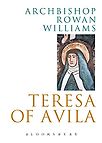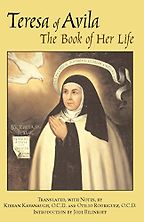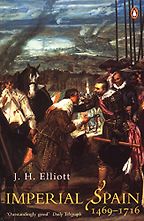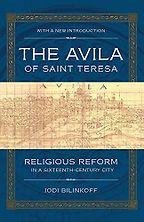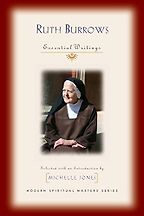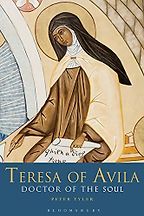A general question before we get to the books about St Teresa of Avila. I think most people, if they know anything about her, know about the Bernini statue, the Ecstasy of Saint Teresa, and that she had these extraordinary, ecstatic religious experiences. I wasn’t even aware, before I started reading the books you’ve recommended, that St Teresa of Avila is a ‘Doctor of the Church’—one of only 36 saints whose doctrinal writings have a particular stamp of authority from the Catholic Church. Could you start by telling us what her greatness rests on?
I have a picture of St Teresa in heaven going up to Bernini and saying, ‘Mr. Bernini, you have some explaining to do.’ I don’t think that statue in Rome begins to tell us what really matters about Teresa. Yes, she had extraordinary experiences, but she was a reformer, a practical reformer. She was a writer and a spiritual director. To see her work as hanging together coherently in all those ways is part of what we need to do to understand her fully. She had a very strong notion of what she meant by the incarnation, the involvement of God and humanity. Everything she says rests on the basis of that. She had a very strong ideal of what the Christian community is like, especially the religious/monastic community, in which a kind of equality is profoundly important. On top of that, she had a lot of extremely insightful things to say about the typical phases or stages of spiritual growth. For herself, that involved a number of certainly very remarkable experiences, which she records, but we shouldn’t come at her through that lens. We should see her as a person who in her own complex context was doing a fundamental job of teaching the Christian faith at a time when women were not expected to be teachers of the faith, let alone Doctors of the Church.
So it’s through her teaching and her practical life as a religious reformer that she became a Doctor of the Church, rather than any sort of great insight she developed as a result of her ecstatic experiences?
Yes. You could say that her long-term experience of prayer and contemplation, including her experience of visions and so forth, was all part of her theological vision. But it’s not as though she listened in to heavenly secrets that are then transmitted to the world. She’s always coming back to the Gospel narrative. I’ve found, in my own reading of her over the years, that her use of biblical texts is itself an extremely interesting clue to how she’s thinking about the faith and about her calling.
Let’s move on to the first book, which is St Teresa’s own Book of Her Life.
This is Teresa’s own account of her journey. It was written at the request of her confessor. She was already attracting a certain amount of unfriendly attention from the authorities, including the Inquisition. It’s worth remembering that, at this time, the Inquisition was very active. We all have the Monty Python view of the Spanish Inquisition. We think of this rather grotesque, monstrous surveillance institution. A lot of it was not like that. It was a huge bureaucracy, more like the Inland Revenue. If you got something slightly wrong, it would be on the books for ages and you’d be pursued for minor debts, as it were. There were, of course, the great set pieces, the public executions, and so forth, but for many people, the real nuisance of the Inquisition was just being harassed constantly, and held accountable for things that were said. All sorts of very reputable, learned and holy figures got into deep trouble with the Inquisition, and took years to get out of it.
Teresa’s confessor was really saying, ‘Look, get down on paper what you think you’re doing, just in case things get difficult.’ Predictably, the Inquisition confiscated copies of the manuscript and it took Teresa several years to get it back. Eventually she had to appeal to the King of Spain to intervene with the Inquisition to get her own book back.
“She famously comes up with the image of irrigation. The soul is like a garden, it needs rain in order to grow. How do you irrigate the soil?”
What she’s doing in The Book of Her Life is explaining why it is that she is a reformer of the monastic life. She describes growing up in a pious household, some of the experiences she had as a child. She describes her early years in the convent, having become a nun at the end of her teens. She describes how, for a while, she was very devout, very prayerful, and then, partly in the wake of a serious illness, it all becomes a bit ordinary, a bit dull. She sinks to the level of most nuns of her day. The convent she belongs to is not spectacularly wicked or corrupt. It’s just a bit cosy. It’s the sort of convent where younger daughters of aristocratic families are boarded out, to while away their lives doing some sewing and going to church, with their own personal attendants and servants as well. Gradually, Teresa became attuned to the fact that there was something wrong. She describes a very significant moment where she has—not literally a vision—but she sees a statue of Christ in the cloister of the monastery and feels a personal appeal. The statue was of Christ being scourged before his crucifixion, of Christ in the middle of his suffering. And she says it was as if Christ were saying, ‘I need you to be with me.’ And that really shifts her perspective. She decides she must reform her order. She begins to petition for leave to found a smaller and more austere convent, and then begins to found more of them.
So, gradually over the years that follow, she spreads this particular style of religious living. That’s not something she tells us a lot about in The Life because her focus in the book is to help us look at the nature of the life of prayer. She famously comes up with the image of irrigation. The soul is like a garden, it needs rain in order to grow. How do you irrigate the soil? How do you make it moist and receptive enough for growth to happen? She describes four stages. At one end is us doing all the work—we can take out the water in buckets and pour it on; we can get machinery to help us; and we can dig irrigation ditches. Or we can just wait for rain. And rain, actual rain, is what’s best for soil. So how do we turn ourselves into soil that is just waiting for rain? That’s how God really does the work. So her sense of the life of prayer is to ask how we gradually let go of our insistence on being in charge of things and doing stuff and, instead, become really receptive. The paradox is that that involves quite a lot of work, but that’s the heart of the argument of The Book of Her Life. And I think that’s what people go back to.
She was absolutely insistent that the reformed Carmelites should only rely on public alms for their sustenance. Is that central to this idea of how Christians should live their lives?
There are two things that come through very clearly in what she says about her communities,and not only in The Life but in other books. One is this vision of the community being small enough to be friendly. This is a community of friends of Jesus, who are able to be friends with one another. Friendship doesn’t depend on hierarchy, so you can’t have elaborate fixed hierarchies. You have a prioress and a cellarer and a bookkeeper, but these offices rotate. When you’ve done your job, you go back to doing the washing up. She’s very clear about that. Because of that, she’s also very clear about the fact that you don’t invest a huge amount in what you might call ‘plant’. You don’t build huge convents, you don’t build elaborate churches, you don’t go wooing the local nobility by saying, ‘We’ll give you a fancy tomb in the church.’ You don’t go fishing for grants of land and property that will give you an income. You need to be dependent—yes, on charity—and whatever you can make by your work. The model is very different from the big sprawling communities that characterised most Spanish cities and, indeed, most southern European cities at that time. These things were very basic for her.
And is The Book of Her Life entirely focused on the development of her prayer life and her spiritual and religious evolution, or does she talk about her family and her upbringing—more straightforwardly autobiographical material?
This is interesting and a very pertinent question. In fact, she does talk a bit about her childhood. What she doesn’t talk about here is her family in detail, because until the middle of the 20th century, nobody really knew this, but her family was Jewish. Her grandfather and her father had been in trouble with the Inquisition at various points, suspected of reverting to Judaism. It’s the familiar pattern: Jewish people were forced to convert in 15th century Spain and then, of course, because they’ve been forced to convert, nobody believes that their conversion is sincere. You can’t win. We know that her father had to leave Toledo because of trouble with the Inquisition and settle in Avila.
Get the weekly Five Books newsletter
Now, Teresa doesn’t mention that. And, frankly, I don’t blame her because if there would be one thing worse than an independent woman teaching about prayer and theology in the 16th century Spanish church, it would be an independent Jewish woman teaching theology and prayer. So she doesn’t touch on that and it was a very well-kept secret for centuries. What is intriguing is the way that subtext appears at a number of points in her writing, as if she is almost daring somebody to call her on it. She says, ‘Of course, it doesn’t matter what your family origins are. This obsession with family, honour and the purity of blood has nothing to do with what happens in the church.’ She is very insistent that her communities will accept people from any background. This is a time when most religious orders were explicitly banning people of Jewish ancestry from joining their communities. We also know that she admitted somebody—we don’t know all the details—from the Spanish colonies in the New World, who seems to have been an indigenous person. Race and religion are something which the community is meant to cut across. So, I think there is an easily discernible subtext when she writes about honour and status. She’s very careful to insist that in the community there should be no distinctions based on family background. In practice, she resisted what were called the ‘statutes of purity’, which denied entry to people of non-pure Christian blood.
Let’s move on to J.H. Elliott’s Imperial Spain.
This is a book which, for me, helps enormously in understanding the kind of society Teresa was part of. I mentioned just now the statutes of purity of blood. What’s happening in 16th century Spain is all in the backwash of the Reconquista, the reconquest of Spain from the Muslim rulers who had held onto parts of Spain until the 1490s. The New Spain, ruled by the Catholic Monarchs, is very self-consciously a kind of flagship of Christian identity and it’s on a bit of a high in the 16th century. The New World is producing enormous amounts of revenue. Gold and silver are flowing in from the Americas. Spain has a well equipped army and navy, it has a massive diplomatic and political presence in continental Europe. Culturally and intellectually, it’s also an immensely creative place. You have some of the leading scholars of Europe, you have the new edition of the Bible produced in Spain during this period, and so on.
Elliott’s book certainly helped me to see how Spain’s confidence really blossomed in this period, after the conflicts of the Middle Ages, and how that blossoming had the deep shadow side of intensifying the contempt for and marginalisation of racial and religious minorities. Muslims and Jews had largely been expelled from Spain by 1492, or forcibly converted. People of ‘mixed blood’, as the Spanish would regard it, were suspect—even if they’d become Christians, like Teresa’s own family. All of that comes together in this sense that Spain is not quite a chosen nation, but certainly a favoured child of God, and has a very special relationship to the Catholic Church.
“The convent she belongs to is not spectacularly wicked or corrupt. It’s just a bit cosy”
Now, already in Teresa’s lifetime, this is beginning to fragment a little bit. We know that, for example, that agriculture in Castile was in decline by the middle of the century. We know that the flood of foreign bullion into Spain actually had a rather depressing effect on indigenous Spanish industry. People didn’t feel they had to work in the same way. People wanting to make a quick fortune in the New World would neglect lands and businesses in Spain itself. So it’s not all as sunny a picture as the propagandists of imperial Spain at the time would have liked to think. By the time of Teresa’s maturity in mid-century, let’s say the 1560s when she’s doing quite a lot of her writing, things are more wobbly than they were. There’s also the awareness, which Teresa certainly reflects, not just of the internal conflicts of the Spanish church, but the new conflicts in Europe, between Catholic and non-Catholic powers.
She’s very much aware of the fact that the Wars of Religion are beginning in France, that there is, as she sees it, violence against the church on the part of reformers. She sees her business in religious reform as being, in part, a response to the attacks on the church that are happening elsewhere in Europe. She knows almost nothing about Reformed theology, and not very much about what’s actually happening. She reads the horror stories, and her response is to those. But it’s all part of the sense that it’s ‘a world in flames’—an expression she used at one point. She might have grown up in the first great glow of Spanish imperial prosperity, in the first half of the century, but that is not looking so favourable by the time she is most active. She’s aware that the systems that she’s taken for granted are more fragile than anybody thought.
Elliott, who is one of the great historians of Spain of the last generation, does give a wonderfully readable account of this rise and fall of confident, expansionist Spain, against which background Teresa makes quite a lot of sense.
Did she see herself as self-consciously serving this great Catholic Spanish adventure, or do you not get a great sense of that?
I don’t think she’s got very much sense of the Spanish project although, interestingly, she has a brother serving in the armies in the New World; there are letters from Mexico. We know that some early Carmelites, including St. John of the Cross, her confessor and great friend, considered missionary work in Mexico. So there’s an awareness of that New World perspective. Teresa is quite clear that the armies of the king of Spain in the New World are doing Christ’s work. She takes that on board quite routinely, but it’s not something that comes up regularly. Similarly, she’s quite happy to make use of her contacts in the royal court at times, even going directly to the king. At the same time, she maintains a fair distance from that world when necessary, and is quite capable of being extremely critical of all its habits.
On the subject of the New World, it’s perhaps worth noting—as one of those completely useless facts—that one of the earliest references to potatoes in European literature can be found in Teresa’s letters. Her brother sends her potatoes from the New World.
Excellent! Since we’re discussing the background, let’s move on to the next book, Jodi Bilinkoff’s The Avila of Saint Teresa next.
Yes. This is a wonderfully vivid and well researched study of the actual civic, urban world in which Teresa lived and it certainly reinforces the impression that this is a city well supplied, or even over-supplied, with religious communities—not untypical of its time.
Avila is, as those who have visited it know, a classic medieval walled city. As with so many others, its geography is marked out with churches and religious communities of different sorts. Bilinkoff’s book gives a very clear sense of just how much the religious and monastic communities were entwined with the economic life of the city. They drew from that economic life, they enjoyed the patronage of various people. They depended quite a lot on aristocratic patronage, on aristocrats buying their tombs in the churches, or indeed buying their retirement homes in convents and monasteries, living on their patrimony within a religious community, when they were no longer particularly active in society.
“Spain is not quite a chosen nation, but certainly a favoured child of God”
Also, of course, as in the rest of pre-Reformation Europe, the religious communities provided social services, employment, and so on, for the population at large. Pretty well every major religious order is represented, even in a middle-sized town like Avila. If you wanted to become a nun or a friar, or a monk, there was plenty of choice. There, as elsewhere, when Teresa founds new communities, she has to overcome just a little bit of suspicion from civic authorities who ask whether they can really cope with yet another convent. Part of what Teresa is eager to promise is that her new foundations will not be a drain on resources.
So, I put Bilinkoff’s book in there because it’s really helpful to see how deeply entwined religious communities were with the civic landscape and how all that worked.
The initial reformed Carmelite convent was in Avila, but did Teresa then found lots of sister communities in her lifetime?
Very much so, which is why she travelled a great deal of the time. Her Book of the Foundations is a very vivid account of just how she stumped around the country, going to places where she thought there might be an opening, where perhaps somebody had written to her saying, ‘We think we could do with a reformed Carmelite convent here.’ This is another reason why the Bernini sculpture doesn’t give you much of a picture. Part of her life is just trundling around Spain in overheated, uncomfortable oxcarts visiting new possible settings for convents. Some of the best-known little anecdotes of her life come from those travels. When she says that we have to think of our human life on Earth as a night spent in a bad hotel, she knows what she’s talking about—you know it’ll be over soon, you’ve got to put up with it, and you’ve got to make the most of it; but there are bedbugs, a draught and overheating.
Did she ever leave Spain?
No. Part of the story of the foundations is the interest which she aroused in the men’s branch of the Carmelite order. She began by reforming the women’s Carmelite order. Then, a couple of youngish friars in the Carmelite order say that the men’s communities could do with something similar. One of the first people to respond to that is the man we know as St John of the Cross, who was a very well-educated young friar, though from a very poor background. He recommits himself—Carmelite sisters and brothers would always take a kind of dedication, so Teresa became ‘Teresa of Jesus’. John of the Cross was originally called ‘John of St Matthew’, and then becomes John of the Cross when he recommits to the reformed order. We know quite a bit about the beginnings of the reform in the men’s order from the letters and the testimonies about the life of St John of the Cross.
“Teresa is extrovert, even flirtatious”
John of the Cross becomes, very importantly, Teresa’s confessor and spiritual director for a period. They’re very, very diverse personalities. They’re clearly deeply fond of each other, and also find each other slightly exasperating. John is very intense, very interior. Teresa is extrovert, even flirtatious. She’s a rather overpowering presence—I think you would know if she was in the room. And I think it’s rather wonderful. The two of them shared so much, exchanged so much and learned so much from each other. There are several notes of Teresa about John of the Cross, but there’s one particular one where she’s talking about a sort of recreation/relaxation period in the convent one day when she’d asked the opinion of various clerical friends on a phrase that had come to her in prayer. She then gives her views, her judgment on each of these comments—rather scathingly. And she says of John of the Cross, ‘And then Father John of the Cross, as usual, went on about darkness and solitude.’ You feel Teresa is teasing him just a little bit.
Let’s move on to Ruth Burrows’s Essential Writings.
The Carmelite order continues to this day and continues to produce some remarkable individuals. Ruth Burrows, otherwise Sister Rachel, of the Carmelite community at Quidenham in Norfolk, is a writer whose work I first came across in the 1970s thanks to a Benedictine friend of mine. Her book, Guidelines in Mystical Prayer, appeared at that point. I have to say, like many other people I was absolutely held and engaged by this completely fresh perspective on the Carmelite tradition of prayer. In this book, Ruth Burrows does a little bit of what Teresa does in The Book of Her Life, that is to say she spells out a set of metaphors leading us from one stage of praying to another and, instead of the metaphor of irrigation that Teresa uses, Ruth Burrows uses metaphors of travel from one island to another. There are territories we come to be at home in, but we have to travel on and the transition between them can be quite difficult.
Fundamentally, as for Teresa, the journey is one from self-reliance to God-reliance. In that process, there are long patches of really not being able to make much sense of things, where you have a not much more than a blind trust that God is still holding onto you. You just have to stay with it and you need people around who will support you in that. Again, part of the book is Ruth Burrows, as the author’s voice, discussing with two other sisters in the community their perspectives on things. She chooses to fix on two sisters of very different temperaments. She speaks about the ‘light on’ and the ‘light off’ temperament. There are those for whom there’s usually quite a strong sense of things being all right, and you can carry on. And there are those who hardly ever have a sense of things being all right, but they know they have to stay where they are.
So, ‘light on’ or ‘light off’ doesn’t really matter because it’s not about whether you’re having wonderful experiences or not. It’s a question of whether your entire self is being turned inside out and opened up to a degree of receptivity to divine love, which will come through you and transform your actions. When I first read this book, I thought it was really one of the best things I’ve ever read on prayer and contemplation. And everything that Rachel has written since then has had very much the same impact. So, I was delighted when a few years ago, this anthology of her writings appeared. And to my mind, she is really one of the greatest teachers of prayer in our own time.
Does the Carmelite tradition of prayer have a very fixed practice, or routine, of the sort to be found in, say, the Spiritual Exercises of St Ignatius?
It’s a good question. In some ways the Carmelite tradition is the absolute opposite of the Ignatian Exercises, because there’s no method prescribed. What is interesting is that Teresa herself was very close to many of the early Jesuits and had huge respect for Jesuit teachers and pastors. She’s not writing it off. Again, when she’s making her teasing comments about St John of the Cross, she says, ‘This sort of thing would be all very well for people who were doing the Spiritual Exercises’. It’s not dismissive exactly, but there’s a ‘That’s alright for those who like it’ feeling.
I suppose the contrast is that St Ignatius, in the Exercises, is trying to encourage people to use their minds and their imaginations almost, in a way, to get beyond them—use your imagination, think of what the words of Christ might have sounded like, what the scene would have looked like, put yourself there in the story, follow through your imaginative instinct and curiosity. Then, at the end of that, ask what you have learned. What difference has it made? What do you go on to?
Five Books interviews are expensive to produce. If you're enjoying this interview, please support us by donating a small amount.
Now, Teresa, I think, would have said, ‘That’s fine, but it’s actually a technique to get you into something else. The something else is where the images and the imagination, the exercise of your mind, will all just freeze and eventually melt and disappear’ because, at the end of it, what you want is a state of being receptive. While you will never stop, at some level, thinking about the human Jesus—she is very insistent on that—you mustn’t get fixated on your own images of that. I think she’s speaking there to people who have already got a bit used to silence and darkness in prayer. She’s not nearly as far from St John of the Cross as she sometimes sounds or pretends she is. Like St John of the Cross, she believes that there is a real dismantling of the routine ways in which we think and imagine that has to go on because so much of our thinking and imagining takes a long detour through the world and lands right back in the middle of the ego—business as usual. And somehow, we’ve got to get beyond business as usual. Meditating on the life of Jesus is fine, and Teresa certainly doesn’t discourage it, but it’s at best a kind of door opener for her. You’ve got to be unstuck, unpeeled from that constant circling back to what’s making you feel good.
Let’s move on to your final book, which is Teresa of Avila by Peter Tyler.
This is a very successful, quite recent overview of Teresa’s thinking as well as her life. There are a number of good lives but this one brings in her thinking, her writing, rather more.
Is Tyler a theologian or an historian?
He’s a theologian and someone who’s written extremely well about the history of spirituality. He’s written a very good book on St John of the Cross, as well. I would recommend this as a really good introduction to her as a thinker. As I said at the beginning, I want us to do full justice to her as a thinker. She is a very original theologian in many ways. She’s a very original reader of the Bible. I mentioned earlier how interesting I found her use of the Bible. Some years ago, I did a short study of which texts from the Gospels she was using, which bits of the Gospels she really liked. She likes St. Luke’s Gospel quite a lot. She likes the stories about women in the Gospels, and she uses them sometimes a little bit mischievously, one might almost say.
There’s a passage in one of her works where she says that she realises that, of course, women must be silent in church and all the rest of it. But, you know, look at the Gospels and who is it who’s there at the cross and the resurrection? It’s the women isn’t it? So, think about that.
She’s fascinated by the figure of Mary Magdalene. In medieval legend, Mary Magdalene is not only a repentant sinner, she’s also a model of the contemplative life because the legend is that she spent her last years as a hermit. The Carmelite order itself began as a group of hermits in the Holy Land. The Crusaders come across this community and bring back the ideals and visions of this group living on Mount Carmel to Europe. So the notion of that prophetic calling to solitude, Elijah on the mountain, remains as part of the background of Carmelite imagination. Mary Magdalene, for Teresa, is a very good example of that solitary and intensely interior life.
Also, Teresa assumes the truth of the medieval legend identifying Mary Magdalene with the sinful woman who washes Jesus’s feet. Behind that is the idea of Mary Magdalene doing something extravagant and embarrassing for the sake of Jesus. She, Teresa, is asking women of her own day to do something extravagant and embarrassing, which is to become Carmelite sisters—to forget their comfort, their reputation, their status. She’s a very innovative, very insightful reader of the Bible.
Is Peter Tyler looking at all those issues? Does he have a particular take in this book on St Teresa of Avila’s life or on her importance as an individual or her role?
I think he would agree with the kind of perspective I’ve outlined here, which is that you have to read her as a real thinker as well as a reformer. You have to read her as somebody who is deliberately commenting on and modifying attitudes to prayer and contemplation at the time. Her theology is contemplative, she draws her theology from her prayer. I think Peter Tyler is very good at weaving those themes together in the book.
I just want to ask one last question, which maybe is one you don’t want to hear. There has been work done on her life that explores whether some of her religious experience was caused by being an epileptic, or rooted in other forms of mental illness or instability. Do you think that that sort of modern theorising—of whatever kind—is helpful in understanding her? Or do you think that, fundamentally, if you don’t try to understand her in a Christian, theological context, you won’t have a clue about what’s driving her and you can’t understand her at all, as a human being?
To be honest, I don’t think that these perspectives tell us very much of real significance about her. Again, it’s the danger of reading her through Bernini’s sculpture, where we see somebody in an abnormal condition. As many commentators have noted, Bernini is depicting somebody who looks as if she’s in a state of orgasm. The imagery of the angel driving a spear to the centre of her body—it doesn’t take a genius to work out the symbolism of that. But this is one episode in Teresa’s life. There are all kinds of accounts that she gives of her personal spiritual experience, which certainly include odd, inexplicable, non-normal phenomena. But all the time she is writing books, she is running convents, she’s founding new convents, she’s travelling around negotiating with unsympathetic town councils, and trying to avoid the Spanish Inquisition. The one thing that she’s not is some kind of mentally fragile person.
I think some of the commentary that focuses on what may or may not be mental or psychological conditions rather takes for granted that anything that looks like explicit and complex religious experience is simply a sign of some kind of mental disorder. You’re in a slightly circular argument there, so I’m not much helped by that.
The case for epilepsy seems to me negligible. If there are episodes and experiences which may result from sleep deprivation, food deprivation, well possibly, yes. These things happen—though she’s not one to encourage excessive self-denial. To understand her, you need to look at what she actually says and does. You need to look at the background against which she works, and speaks. That’s why I think you need to locate her in the context in which these books help to place her.
Interview by Benedict King
August 30, 2021. Updated: September 2, 2021
Five Books aims to keep its book recommendations and interviews up to date. If you are the interviewee and would like to update your choice of books (or even just what you say about them) please email us at [email protected]

